Vacation Bali
Street vendors come out of the woodworks
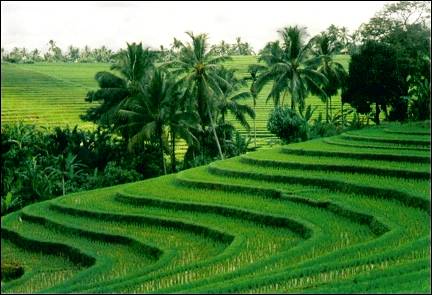
|
Bali, the green island with volcanoes, lakes and paddies, has more to offer than natural beauty: painters, sculptors, gold- and silversmiths, woodcarvers, (gamelan) orchestras, batik workshops, Hindu temples and of course Balinese dance. The only downside: it takes a lot of energy to keep the street vendors at bay.
Travelogue & photos: Angelique Woudenberg
It is already dark when we arrive at Ngurah Rai Airport, Bali's airport. And it's only 6:20 PM. Because Bali is so close to the Equator, the days are as long as the nights: 12 hours of light and 12 hours of darkness.
Canggu - Denpasar - Batubulan - Celuk - Ubud
Today's highlight is the monkey dance
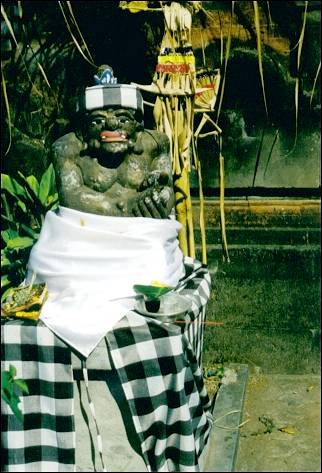
|
This is the closing week of the "Galangan & Kuningan" period, during which all Balinese Hindus invite their ancestors to descend to earth to celebrate the triumph of Good over Evil. The "Galangan & Kuningan" is celebrated every 210 days.
As soon as we arrive in Denpasar, we're overwhelmed by the chaotic traffic. Mopeds drive like madmen and when the bus stops for a traffic light, they surround us like a swarm of mosquitos. Traffic in Bali keeps to the left and it's definitely not advisable to rent a car here.
Our guide Katut gives us information about the area and the first village we're going to visit, Batubulan. This literally means "stone moon," as in Batu "stone" and Bulan "moon."
Batubulan is famous for its workshops where stone sculptures are made of volcanic ash, the so-called "Paras." This is a grey type of stone that is often used in Bali to make statues for temples.
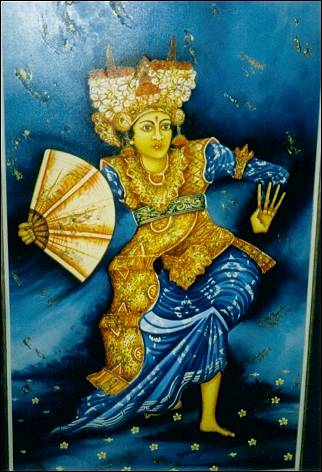
|
We visit a workshop where stone sculptures are made and watch a man hack a shape from one of the grey blocks of stone. Artful but also exhausting. Behind the workshop we see a number of statues that we'll see quite often during our trip.
Katut tells us that in Bali you will often see statues wrapped in black-white-grey checkered cloth, the so-called Poleng cloth. Why? The color black is a symbol of Evil and white is a symbol of Good and man is a mix of both, hence the grey.
The village Celuk is known for its gold- and silversmiths. We visit the workshop "Dewi Sitha." An employee explains how jewelry is made and then we're quickly taken to the store, where we are supposed to buy jewelry.
Ubud is an artists village. We visit a workshop where beautiful paintings are made. Katut tells us that deep inside every Balinese is an artist.
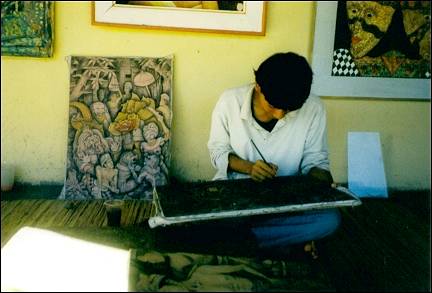
|
Our next stop is at Pasar Ubud, the village market. We get one and a half hours to shop. The market is not what we expected: it's very crowded, there's a terrible stench and all stalls sell the same knick-knacks.
After half an hour we've seen everything and find a place near the market where we eat delicious Indonesian food. Finally we drive back to Batubulan, the village where we visited the sculpturers workshop this morning. This is going to be the hightlight of today: the Kecak Dance (Monkey Dance).
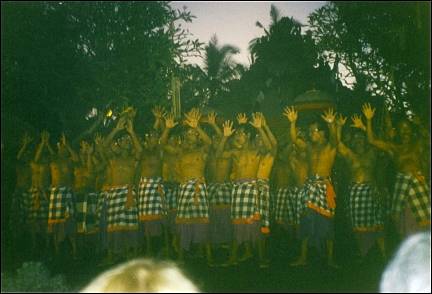
|
The word "Kecak" derives from the "cak cak" (pronounce "chak chak") sounds that are sung by a male choir who are sitting around a fire.
Before the performance begins, we get a sheet with the story of the Monkey Dance, which is a good thing, because without it we wouldn't have understood anything of the story.
Tourist Resort Kuta
Directly behind the swimming pool is the Indian Ocean
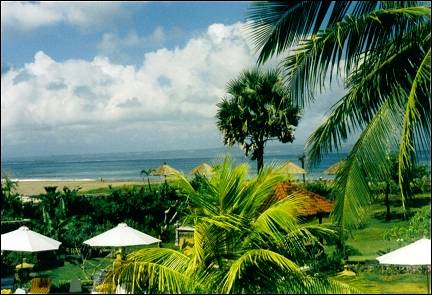
|
After a tasty breakfast we first relax for a while at the swimming pool. Around it is a beautifully designed tropical garden and behind that some kind of theater.
Directly behind the swimming pool is the Indian Ocean, which can be reached through a small gate. Unfortunately, we can't swim in the ocean here, because there is a dangerous undercurrent.
As soon as I have entered the beach, I get assaulted by all kinds of vendors who seem to come from the woodworks and try to sell me watches, sarongs, massages, pedicures, hairpins and assorted junk. I thank them politely for their offers, then turn around and walk back to the hotel gate, re-entering the "safe zone."
In the afternoon we take the shuttle bus to Kuta. They drop us off in the shopping district, "Jalan Legian" (Legian Street). It is 6 km (4.5 miles) long and has mainly souvenir shops, internet cafés, "Wartells", where you can make cheap phone calls, a McDonalds and a huge department store, "Matahari."
We're constantly approached with "Hello, where you from?" "Buy watches?" "Lookie Lookie", "Good price for you", "You need transport?"
Most Balinese are Hindus and sacrifices are an important part of their religion, as we almost immediately notice. Every Hindu makes at least three times a day sacrifices to honor the spirits; not just at home or in the temple, also in Legian Street we see baskets for offerings, at the check-out, in McDonalds, in the bathroom, in the bus, even in front of the entrance of a store.
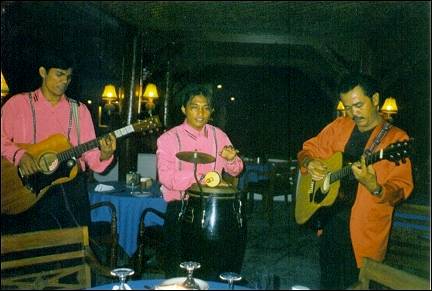
|
At night an Indonesian orchestra plays in the hotel.
Canggu - Besakih - Klungung
Large groups of Balinese make sacrifices and perform rituals
We leave early to visit a weaving mill, where we learn about the process of batik, which is conducted in eight steps.
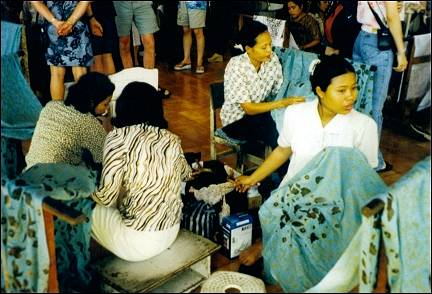
|
We drive to a traditional Balinese village, where we visit a house. What terrible poverty. Grandmother and grandfather sleep on the floor in a dark corner next to the kitchen. We're not told where the rest of the family sleeps.
All houses in the village are on one narrow, steep street. Every house has its own gate. The decorations on the gates show the wealth of a family: when it is richly decorated, the family is wealthy. Behind the street is a bamboo bush with pigs, where we take a walk.
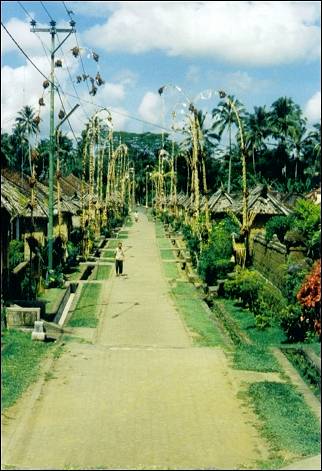
|
Balinese villages are communities consisting of compounds where whole extended families live. Their lands are considered ancestral property and in front of every house we see offering baskets.
Because of the "Galangan & Kuningan" period the street is decorated with bamboo poles, the so-called "penjors."
We chat with a few villagers and children and then get back on the bus.
A long drive brings us to the most important temple complex of Bali, the Pura Besakih. "Pura" means temple. The Pura Besakih consists of various temples that are scattered over the slopes of the sacred volcano Gunung Agung.
This active volcano is the largest on Bali and plays an important part in the lives of the Balinese, because they believe that the spirits of the ancestors dwell here. Because of this, the Pura Besakih was built here.
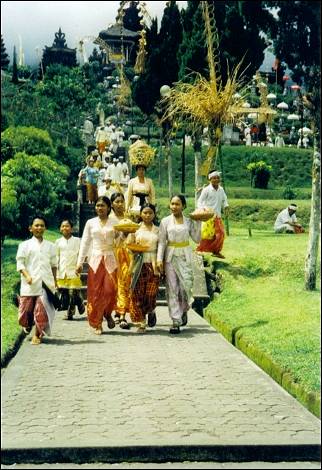
|
Before we can admire the Pura Besakih, there's a one kilometer (0.75 mile) climb. Because of the conclusion of the "Galangan & Kuningan" this week, there are lots of religious ceremonies taking place in the courtyards of the Pura Besakih temples.
Hindu women and girls, dressed in beautiful sarongs, bring offerings in baskets that they carry on their heads to the temple. They have to take the same steep road as we. Amazing that they can do that. The tourists in their loud sarongs shuffle behind them.
It's very crowded in the Pura Besakih. Big groups of Balinese, all of them in their best clothes, bring sacrifices and attend ceremonies in the most important part of the temple, the courtyard. We're not allowed to go in there. We walk around the complex and then go back to the bus.
We have lunch in a restaurant between beautiful green sawas (paddies) which are constructed as terraces.
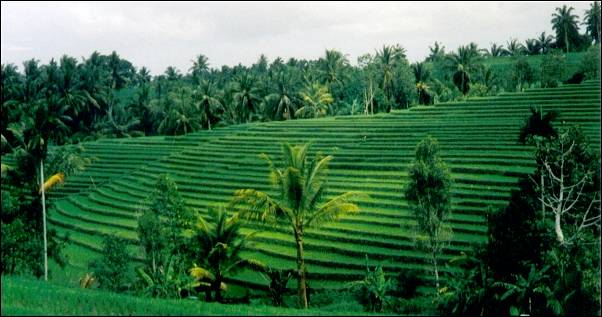
After lunch we drive to the village Klungkung and visit the remains of the Palace of Klungkung, the Taman Gili. We see one of the 18th century meeting halls. The teak furniture also stems from that period, according to our guide. We like the paintings on the ceiling, with human figures and dolls. We take a short stroll through the beautifully layed out garden. Once we leave the palace grounds, we are immediately beleagered by street vendors.
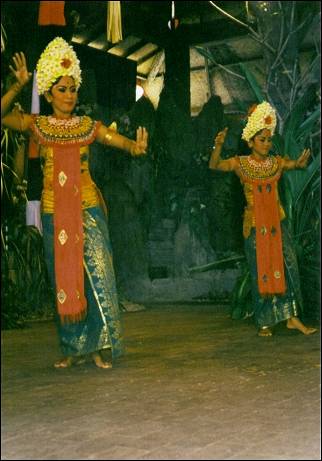
|
That evening we have dinner at the restaurant of the Bungalow Park next to the hotel.
To our surprise, there's a wedding party going on. The bride and groom are Dutch, but they are dressed in traditional Balinese costumes. Everyone in the restaurant, including us, gets a lily behind their ears.
We're also treated to performances by Balinese dancers in gorgeous traditional costumes, accompanied by a Gamelan orchestra.
Volcano Trip
Hordes of street vendors are awaiting us
We get up early for another trip. Our guide Wayung first gives us general information about Indonesia: it has 17.000 islands; best known are Sumatra, Kalimantan (formerly Borneo), Sulawesi (formerly Celebes), Java, Lombok and of course Bali.
Indonesia is the largest Muslim nation in the world, but on Bali, Hinduism is the main religion. Wayung explains the caste system and family names in Bali. Hinduism has four castes, called Varna: Brahmans, the highest caste, then warriors, merchants and finally farmers, who are the lowest caste.
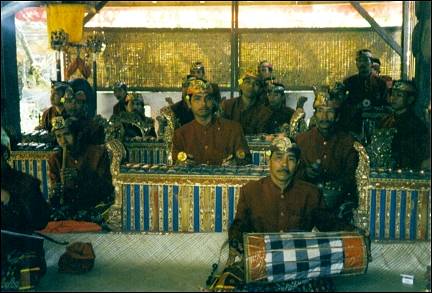
|
Family names contain information about caste: if someone is called "Wayan," he belongs to the third caste. If the name is "Wayan Ayu," it means this is a woman. "Ayu" means female as well as beautiful.
Our first stop is in Batubulan, the same village we visited a couple of days ago. This time we watch an hour-long Barong & Kris dance performance. The show has 5 acts and is about the spirits of Good and Evil. The dragon Barong symbolizes the good spirit and the witch Rangda stands for evil. The performance is accompanied by a Gamelan orchestra. Before the show we get a sheet with an explanation of the show.
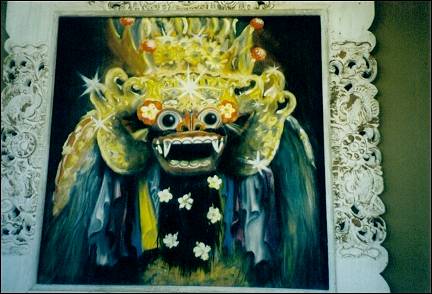
|
In another village, Mas, we visit a wood-carving workshop. A boy tells us that it employs seven people, who work six hours every day. On average, it takes three weeks to complete a sculpture.
Each worker has his own task: one hacks out the crude contours, one works on the fine carving, other sand or polish.
The downside of this occupation is dat it causes back problems, which doesn't surprise us when we see in what conditions people have to work: cross-legged on the floor, without air conditioning. But the results are artful. The kid also tells us that they work with five different kinds of wood: white crocodile wood, mahogany, teak, sandelwood and ebony.
The kid warns us not to buy sculptures from street vendors - they are fake, something you can see because the colors aren't solid and there are white streaks on the back. He takes us to the store, where we're of course expected to buy something.
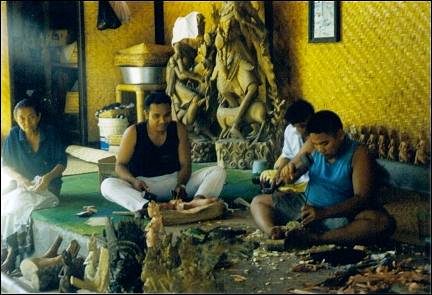
|
We actually see some very nice teak tables, but it's a pain in the neck to import it in Holland. We thank the kid for the tour and continue our trip to the next sight: the herbs wood.
Before we get off the bus, the guide warns us that there will be hordes of street vendors waiting for us. If you inquire about the price, it is taken as a sign of interest. If you're not interested, they keep following you. If you decide to buy something, the prices are immediately raised again.
Without looking up, we walk to the herbs forest. It has all kinds of trees: papaya, banana, pineapple, coffee and clove. Near the exit there is of course a store where you can buy products made of the produce. Medicinal headache cream made of cloves and pure oils in bottles, like peppermint and lavender oil.
Kintamani and Lake Bratan
The clouds hover just above the water surface
We have lunch in another village, Kintamani. The restaurant has a view of Bali's most active volcano, Gunung Batur. Its latest eruption took place in 1994. The volcano slopes are bare. To the East of the volcano we see Lake Batur. It is the most important source of water for agriculture in Middle and East Bali. We search for pieces of lava for my stone collection and after a short walk we find some pretty lave rocks.
Our last stop is in the town of Tampaksiring where we pay a visit to Pura Tirta Empul, the Temple of the Sacred Source. Our shoulders and knees are covered, but we still get purple ribbons around our waist, out of respect for Hinduism.
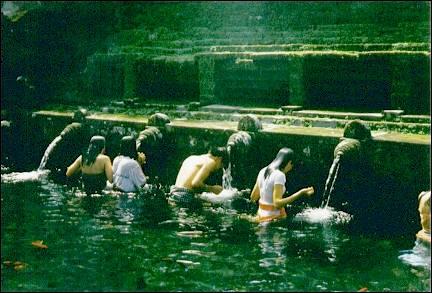
|
The temple has baths with holy water and we watch Balinese washing themselves, with their clothes on. I decide to paddle and afterwards my legs feel as reborn.
Today is a holiday in Bali and the stores are closed. So we decide it's a good day to relax at the swimming pool.
Next morning we get up early, it is our last full day here and we're taking a day-tour. Our English-speaking guide is called Aska. We're handed a map of Bali with the places that we're going to visit marked.
Pupuan is in the most rainy part of Bali and the surrounding area is cool and mountainous. Before we can admire the beautiful green sawas, we have to drive a long way on snaking, steep roads.
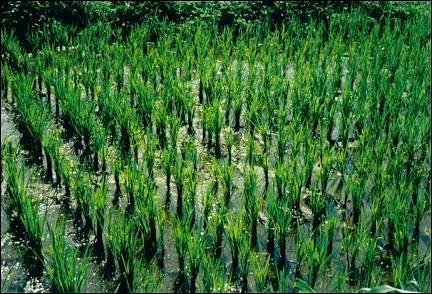
|
When we arrive at the rice terraces, Aska tells us how they were constructed. Each paddy has its own scarecrow and poles with plastic bags to keep away the birds.
We walk through a small wood and are told which products are made from banana trees and palm trees.
At Lake Bratan it rains and it's cool, only 17° Centigrade. There are many Balinese here as well, a visit to the lake is probably a family outing. We walk towards the lake, where the clouds almost touch the water. Many Balinese are fishing; jet-skiing is also possible.
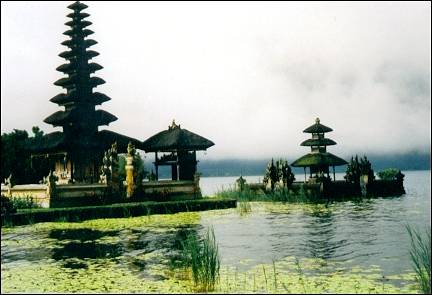
|
Our guide gives us information about the temple on Lake Bratan, Pura Ulun Danu Bratan. It has three niches, one for Hindus, one for Muslims and one for Buddhists. This explains why Bali is called "Island of the Gods."
Just before the exit of the temple grounds, we can have our picture taken with a gigantic python. We don't take the risk, but we take a picture of the python in its basket. What a horrible beast.
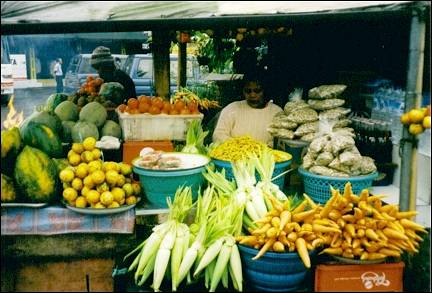
|
Our next stop is in the nearby town of Bedugul where we visit the flower and herbs market. It's still raining and the market isn't much to write home about.
It is too bad that this is our last day in Bali. In Denpasar we're again confronted with the traffic chaos. It's rush hour and the mopeds race around like crazy. We see a lot of Balinese on mopeds and in cars dressed their best. The women wear pretty sarongs with ribbons around their waists and the man are dressed in white with white shawls covering their heads. On their way to the temple to honor the spirits.